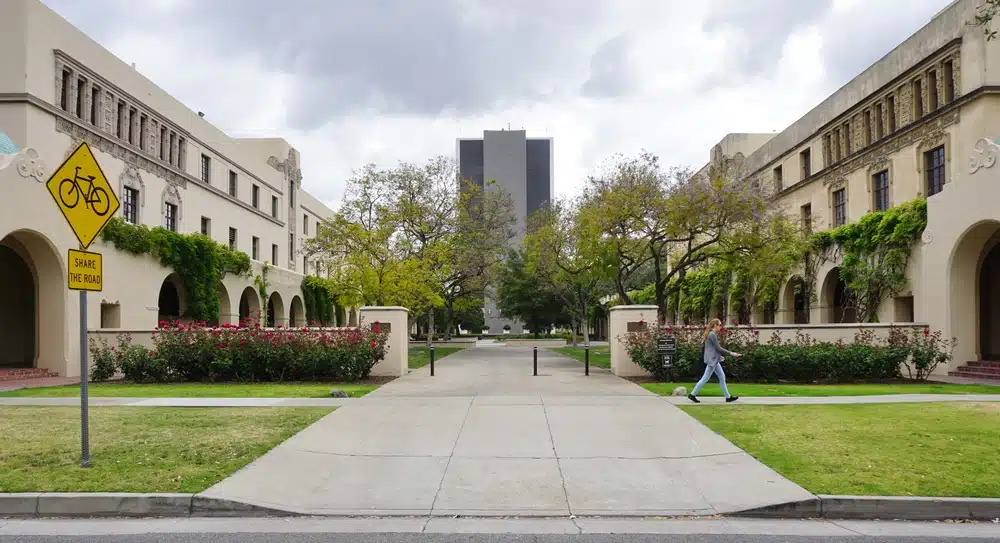What to Know About the Caltech Waitlist for 2025
If you’re a prospective student who has applied to the California Institute of Technology (Caltech) for the academic year 2025, understanding the waitlist process can be essential. This guide will help you navigate through each stage of the Caltech waitlist process and effectively manage possible outcomes.
Understanding the Caltech Waitlist
When it comes to the highly competitive admissions process at Caltech, understanding the Caltech waitlist system is crucial. Like many other prestigious universities, Caltech uses the waitlist to manage its admissions process more effectively and ensure that every available spot is filled with the most qualified candidates.
The Purpose of the Waitlist
The main purpose of the waitlist at Caltech is to provide the university with a safety net. It acts as a contingency plan in case the number of accepted students who choose to enroll at Caltech is lower than anticipated.
By having a waitlist, the university can ensure that it will have a full incoming class, regardless of the decisions made by initially admitted students.
Furthermore, the waitlist allows Caltech to carefully manage its yield rate, which is the percentage of admitted students who ultimately decide to enroll. If the yield rate is lower than expected, the waitlist provides an opportunity to fill any remaining spots with highly qualified students who are still interested in attending Caltech.
How the Waitlist Works
Once the admissions committee has thoroughly reviewed all applications, they carefully select a group of students who they believe would be an excellent fit for Caltech academically and culturally. These students, although not initially offered admission, are placed on the waitlist.
Being on the waitlist means that the admissions committee recognizes the potential of these students and is willing to consider them for admission if places become available.
On the Caltech waitlist, students receive an opportunity to be reconsidered for admission until mid-April, in case openings become available in the class after May 1. It is advisable for students to submit supplementary materials to enhance their applications.
In cases where class vacancies remain after May 1, the institution conducts a review of applications from students who have chosen to be reconsidered. Importantly, the waitlist operates without a ranking system. Communication with waitlisted students takes place, and the waitlist process concludes around mid-July.
However, it’s important to note that being on the waitlist does not guarantee eventual acceptance. The number of students admitted from the waitlist varies each year and is largely dependent on the yield rate of the main admission offers. If the yield rate is higher than expected, there may be fewer spots available for waitlisted students.
For students on the waitlist, it can be a period of uncertainty and anticipation. They must carefully weigh their options and make decisions about other college offers while still holding out hope for a spot at Caltech. It’s a waiting game that requires patience and flexibility.
Throughout the waitlist period, Caltech remains in close contact with the waitlisted students, providing updates and information about the process. Students on the waitlist may be asked to submit additional materials or updates to their application, such as updated grades or achievements, to strengthen their candidacy.
In the end, the Caltech waitlist serves as a valuable tool for the university to ensure that every available spot is filled with the most qualified and deserving students. It provides an opportunity for highly talented individuals who may have narrowly missed the initial round of admissions to still have a chance at becoming part of the Caltech community.
Factors Influencing the Caltech Waitlist
Admission Statistics
Admission statistics play a vital role in determining the size and composition of the Caltech waitlist. The number of applications received, the overall acceptance rate, the yield rate, and the targeted class size all influence how many students end up on the waitlist.
In recent years, Caltech has become increasingly selective. For the Class of 2025, Caltech had an acceptance rate of approximately 7 percent. This means that out of thousands of applicants, only a small fraction are offered admission.
The university carefully evaluates each application, considering factors such as academic achievements, extracurricular involvement, and personal qualities.
Furthermore, the yield rate also varies, although it’s usually quite high due to the university’s prestigious status. Caltech’s rigorous academic programs and exceptional faculty attract a high number of admitted students who choose to enroll. However, even with a high yield rate, there are still limited spots available in each incoming class, leading to the formation of a waitlist.
This intense competition means that many high-quality applicants end up on the waitlist. These applicants have demonstrated exceptional academic potential and a strong passion for scientific research and innovation, aligning with Caltech’s mission and values.
Impact of Early Action and Regular Decision
The balance between Early Action (EA) and Regular Decision (RD) applicants can also impact the waitlist dynamics. Caltech, like many other universities, offers both Restrictive Early Action and Regular Decision admissions processes, and the yield rates for these two groups can differ substantially.
Caltech’s REA policy allows students to apply early without a binding commitment, giving them a competitive edge in the admissions process.
Applying under REA can demonstrate students’ strong interest in Caltech and their commitment to the application process without being locked into attending the university if they are accepted. If admitted, REA applicants can still consider other offers, potentially complicating waitlist decisions.
On the other hand, RD applicants have until the regular decision deadline to make their final college choice. This flexibility can lead to more uncertainty in the enrollment numbers, as some RD applicants may receive multiple offers and take more time to decide.
If the yield rate for RD applicants falls short of expectations, then the university may admit more students from the waitlist to fill the remaining spots in the incoming class.
Caltech carefully manages the waitlist to ensure a diverse and talented student body. The admissions committee considers various factors when making waitlist decisions, including the academic profile of the applicant, their potential contributions to the Caltech community, and the university’s overall enrollment goals.
Navigating the Caltech Waitlist Process
Navigating the Caltech waitlist process can be complex, as the number of students admitted from the waitlist varies from year to year, making it crucial to understand the dynamics and strategies involved.
In Fall 2021, Caltech extended offers to 268 applicants to join their waiting list, but no reported applicants were ultimately admitted from this waitlist. In the preceding year, Caltech maintained a waitlist with 312 applicants, of which 235 students accepted their positions. From this pool, 10 waitlisted students were fortunate enough to receive offers of admission to Caltech.
This fluctuation in the numbers underscores the unpredictability of the admissions process and the varying demand for spaces in the incoming class each year.
Now, let’s explore the intricacies of the Caltech waitlist, offering insights and tips to help you navigate this often challenging phase of the admissions process effectively.
What to Do If You’re Waitlisted
If you’ve found yourself on the Caltech waitlist, there are some proactive steps you can take. First, confirm your spot on the waitlist by responding to the waitlist offer. Not everyone who’s offered a spot on the waitlist will accept, so ensure you make your interest known.
Once you’ve confirmed your spot, it’s important to understand the waitlist process at Caltech. The admissions office will review the waitlist regularly and make decisions based on the number of spots available and the strength of the waitlisted applicants. This means that your chances of being admitted off the waitlist can fluctuate throughout the process.
As mentioned earlier, Caltech encourages students to augment their applications with supplemental materials that can offer the admissions committee a more comprehensive insight into their qualifications. These materials can encompass a variety of items, such as:
- A research paper, abstract, or publication (if published, please include a citation, letter of evaluation, and research description)
- A maker portfolio showcasing your creative and technical work
- Visual art pieces that showcase your artistic talents
- A detailed description of any relevant internship experiences
In the event you are placed on the waitlist, you will receive a link to access the Caltech application portal (Beaver Breakroom) after the application deadline. This portal will contain comprehensive instructions on how to upload and submit your supplemental materials, allowing you to bolster your application while awaiting a final admission decision.
While waiting for a decision, you can also consider enhancing your application. While you shouldn’t rewrite your entire application, you can update it with any significant new achievements since submission. This could be an improvement in marks, additional recommendation letters, or prizes won. Making such updates can boost your standing on the waitlist.
Furthermore, take this time to reflect on why Caltech is the right fit for you. Consider what unique contributions you can make to the Caltech community and how the university aligns with your academic and career goals. This self-reflection can help you articulate your passion for Caltech if you have the opportunity to communicate with the admissions office.
Communicating with the Admissions Office
Regular, but respectful, communication with the Admissions Office can help your situation. You may wish to express your continuing interest in Caltech and provide them with any updates on your academic standings or significant extracurricular achievements.
However, remember to strike a balance. While it’s good to demonstrate your enthusiasm for Caltech, too much contact can appear desperate or pushy.
Aim to send updates every few weeks or when you have substantial new information to share. This way, you stay on their radar without overwhelming them with constant messages.
In your communications, be genuine and specific. Share your genuine excitement about the possibility of attending Caltech and highlight any specific aspects of the university that resonate with you. This personal touch can help you stand out among other waitlisted applicants.
Additionally, if you have any questions about the waitlist process or need clarification on any aspect, don’t hesitate to reach out to the admissions office. They are there to assist you and provide guidance throughout the process.
Remember, being on the waitlist means there is still a chance of being admitted to Caltech. Stay positive, continue to work hard, and make the most of any opportunities that come your way.
The Timeline for the Caltech Waitlist
When to Expect a Decision
If you’re on the Caltech waitlist, you might be wondering when you can expect to hear about a decision. Waitlisted applicants can typically expect a decision by mid-July, as this is after colleges have received responses to their initial admission offers.
During this waiting period, it’s natural to feel a mix of excitement and anxiety. You may find yourself constantly checking your email or mailbox, eagerly awaiting any updates from the admissions office. It’s important to stay patient and remain hopeful, as the waitlist process can be unpredictable.
While the general timeline for waitlist decisions is late spring or early summer, it’s essential to keep in mind that each year can vary. Factors such as the number of admitted students who decline their offers or the overall size of the waitlist can influence the timing of decisions. To stay informed and get the most accurate information, it’s always a good idea to reach out to the Caltech Admissions Office directly.
What Happens After the Waitlist Decision
Being accepted off the waitlist is a testament to your qualifications and potential as a student. It’s a moment of celebration and relief after the long waiting period.
Once you receive the good news, you’ll have a specific, although typically short, amount of time to accept the offer. This window of time is crucial, as it allows you to carefully consider your options and make an informed decision. It’s important to weigh the pros and cons of attending Caltech against any other college acceptances you may have received.
On the other hand, if you’re not admitted from the waitlist, it’s time to plan for the next steps. Receiving a rejection can be disappointing, especially when you’ve invested time and effort into your application. However, it’s important to remember that this outcome does not define your worth or potential.
Caltech is known for its highly competitive admissions process, and the waitlist is just one of the realities of applying to such a prestigious university. It’s essential to keep a positive mindset and focus on the other opportunities that will present themselves. Remember, success can be achieved in various institutions, and you have the potential to thrive wherever you end up.
Take the time to reflect on your other college acceptances and carefully consider which institution aligns best with your academic and personal goals. Each university offers a unique experience, and it’s crucial to choose the one that feels like the best fit for your future.
Whether it’s Caltech or another institution, your dedication and hard work will undoubtedly lead you to success.
Preparing for Possible Outcomes
Waiting to hear back from a college can be a nerve-wracking experience. You’ve put in all the hard work and submitted your application, now it’s just a waiting game. But what happens when you find yourself on the waitlist? It’s important to be prepared for all possible outcomes and have a plan in place.
Planning for Acceptance
If you get the happy news that you’ve been accepted from the Caltech waitlist, it’s time to start planning your next steps. First and foremost, confirm your acceptance. Let the college know that you’re thrilled to be given this opportunity. Once that’s done, it’s time to think about housing.
Depending on the college, you may have different options available to you. Some colleges offer on-campus housing, while others may have off-campus options or even homestays. Take the time to research these options and choose the one that best suits your needs.
Once your housing is sorted, it’s time to get your enrollment documents in order. This may include submitting your official transcripts, completing any necessary medical forms, and paying your enrollment deposit. It’s important to stay organized during this process to ensure that everything is submitted on time.
Another important step is attending any available orientation programs. These programs are designed to help you familiarize yourself with the campus, the faculty, the courses, and your future classmates. It’s a great opportunity to ask any questions you may have and get a feel for what your college experience will be like.
Dealing with Rejection
Rejection is a difficult pill to swallow. After putting in so much effort and hoping for the best, it can be disheartening to receive a rejection letter. However, it’s important to remember that being waitlisted already places you among a highly competitive pool of applicants. The fact that you made it to the waitlist stage is a testament to your abilities and accomplishments.
If you’re not eventually accepted, it’s not a reflection of your abilities but rather a matter of space limitations. Colleges receive a large number of applications each year, and unfortunately, they can’t accept everyone. Take the time to process your disappointment, but then refocus on your other possibilities.
Remember, any college experience is what you make of it. You have the potential to achieve great things wherever you go. Take this opportunity to explore other colleges that have accepted you or consider alternative paths such as community college or gap year programs. There are many different roads to success, and this rejection is just a detour on your journey.
Use this experience as a learning opportunity. Reflect on what you can improve in your future applications and continue to work hard towards your goals. Setbacks are a part of life, but it’s how you respond to them that truly matters.
Navigating the Caltech waitlist can be a challenging and uncertain phase in the college admissions process. At this critical period, AdmissionSight stands ready to assist and support students.
Our experienced team is well-versed in the nuances of the waitlist process and can provide guidance on preparing and submitting supplemental materials, crafting compelling letters of continued interest, and ensuring that you remain well-prepared for any potential opportunities that may arise.
With AdmissionSight’s expertise and support, you can approach the waitlist with confidence and determination.










































